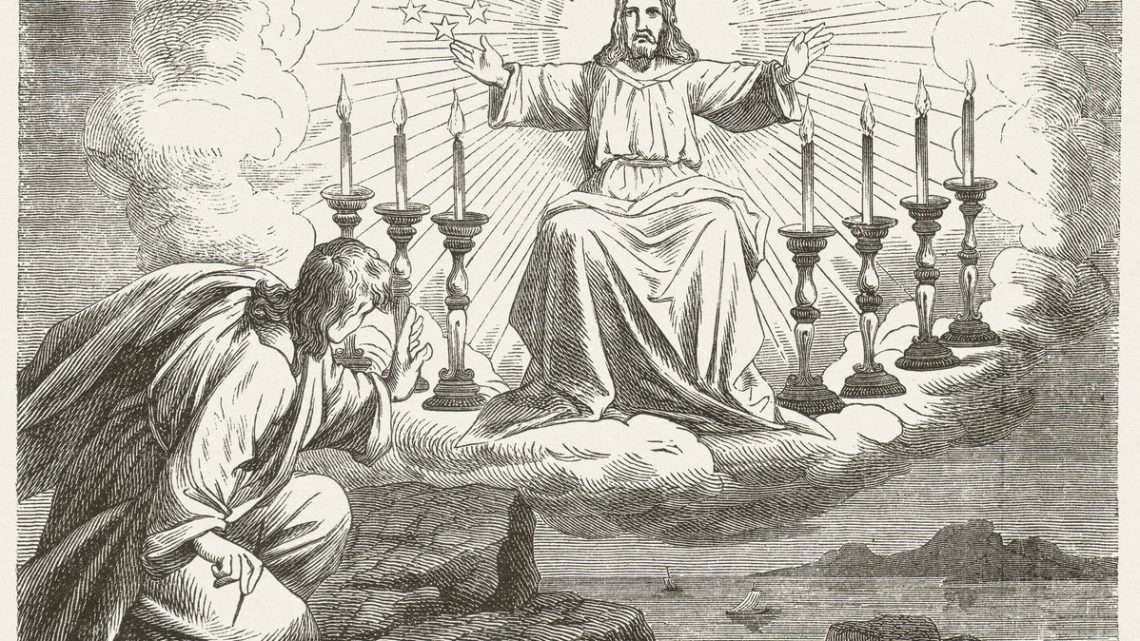Sabbath School Lesson for April 14-20, 2018
Surprisingly, the book of Revelation might be considered the book of the New Testament that is closest in nature to the Old Testament. With 2,000 allusions, references, and quotations taken from the Old Testament, some have claimed that the study of Revelation almost demands a person to be proficient in the Hebrew language.
The book of Daniel ends and Revelation begins with a blessing for those who read their pages, and subtly suggests its worth for those living near the end of time. The prophecies and counsel in both books are very similar, and thoughtful Bible scholars have always studied them together.
One must study Revelation for more than its symbols and prophecies, however. Just like with Daniel’s story, we find much counsel on how we are to repent and serve the Lord, as we prepare for the Second Coming.
The person of Jesus comes shining forth throughout Revelation. It is truly a revelation of our Savior, not just an exposition telling what will happen in the future, as some have seen it. At the beginning, John clearly defines this book as being the Revelation OF Jesus (ch. 1, v. 1) and FROM Jesus (ch. 1, v. 5).
We certainly see Jesus IN it as well, from…
- His waging war with Satan (Revelation 12:7),
- His role as the Passover Lamb (Revelation 5:6), and
- His shining, final entry back to earth on a white horse (Revelation 19:11).
Yes, Jesus is our ticket to understanding how to prepare for the end times.
Focus Text: “To the one who is victorious, I will give the right to sit with me on my throne, just as I was victorious and sat down with my Father on his throne.” Revelation 3:21 NIV
Matthew 19:28 records Jesus making this same promise to His disciples while He was still on earth. “Overcoming” and “following” Him, are other expressions used to express this victorious living. The admonition remains the same. We must stay close by Jesus’ side, in order to experience the final victory and reward of being with Him in heaven.
Sunday: The Structure of Revelation
Many similarities exist between the books of Daniel and Revelation. They both consist of historical and eschatological (dealing with the last days) events. In addition, the idea of a judgment is found prominently in the center of both books, as seen in Daniel 7 and Revelation 14.
Leviticus 16, the center of the Pentateuch (the five books of Moses), also brings the Day of Atonement to the forefront of the sanctuary services. This Day of Atonement was considered a day of judgment for God’s people. The peak of the salvation story then seems to be when God ultimately sits as Judge.
Understanding the literary structure of Revelation helps us glean the most from its pages:
- The first part focuses on John’s day to the coming of Christ (ch. 1-11).
- In the latter half (ch. 13-22), we see what happens from the judgment down to the time when the heavenly city, New Jerusalem, descends to earth.
Revelation 12, the center of the book, gives us insight into the entire cosmic conflict,
- beginning with the war in heaven (Revelation 12:7-9),
- Satan’s attack on the Babe in Bethlehem (Revelation 12:4),
- the persecution and flight of Christians in subsequent church history (Revelation 12:14-16), and
- a warning about Satan’s attack on God’s people in the last days (Revelation 12:17).
Discussion Questions:
Read 1 Corinthians 10:1-11. What symbols in Revelation are revealed from these Old Testament stories of Moses’ time? How do the “cloud”, “spiritual food”, the “Rock”, and the “serpent” in these stories help us understand the symbols we read about in Revelation?
Read Revelation 12:4, 14-16, 17. Describe the three periods of Christian persecution covered in this pivotal chapter in the center of the book of Revelation.
Why is it important to focus on the victory found in the book of Revelation rather than on the persecutions depicted there? How can we keep that victory in mind, as we read about the troubling times that occur right before the Second Coming?
Monday: Images of Jesus
Some of the many depictions of Jesus in Revelation are…
- the faithful witness, firstborn from the dead, and ruler over the kings of the earth (Revelation 1:5 and Colossians 1:18)
- the resurrection and the life (Revelation 1:18 and John 11:25)
- the Lamb (Revelation 5:8 and John 1:29)
- Faithful and True, the Word of God, a mighty ruler and warrior (Revelation 19:11-15 and John 1:14)
- Alpha and Omega (the Beginning and the End), giving living water (Revelation 21:6 and John 4:10)
Although the return of Jesus is important, so also is His life, death, and resurrection. Only by knowing Him intimately in all of these roles can we make the moral decisions necessary to survive the persecutions that have, are, and will come upon God’s people.
Discussion Questions:
Read 1 Corinthians 5:7. How was Christ meant to be seen in the celebration of the Passover? Think back to the story of how the firstborn of the Hebrews were saved from destruction during the very first Passover in Egypt. How did their trust and obedience portray how we are to be redeemed, before and after the cross?
Read Revelation 1:18 and Romans 6:9. Why is it important for Jesus to have the keys of Hades (or hell, or the grave) and death? How did He gain access to these keys? What does this mean for our future?
Read Revelation 1:7, 5:11, Acts 1:9, and Matthew 16:27. How did Jesus go back to heaven after His resurrection, and how does this compare with what the clouds apparently consist of when we see Jesus coming again?
Tuesday: The Sanctuary Motif in Revelation
Our images of Jesus in the book of Revelation rightly show His place and work in the heavenly sanctuary. The earthly sanctuary was meant to be a teaching tool, showing us what the plan of salvation means to mankind. Therefore, we must become immersed in the Old Testament model, if we are to make sense of John’s vision, as recorded in Revelation.
John begins the telling of his vision (Revelation 1:10-18) with Jesus in the first apartment of the sanctuary, or the Holy Place. Seeing Him amid seven lampstands reminds us of the lampstand with its seven lamps in the first apartment.
His counsel to the churches in chapters 2 and 3 indicates His work of ministering to God’s people throughout church history, which was obviously through the study of His Word (symbolized by the table of showbread) and receiving of their prayers (symbolized by the altar of incense).
Revelation 11:19 introduces us to the Most Holy Place, where the ark of the covenant was located…
“Then the temple of God was opened in heaven, and the ark of the covenant was seen in His temple. And there were lightnings, noises, thunderings, an earthquake, and great hail.” NKJV
We are given a glimpse here of the second part of His ministry, bringing us ever closer to the final judgment and the creation of a new heaven and new earth. This glorious ending that all of God’s righteous await with ever-increasing enthusiasm is soon to come. How comforting to know that Christ’s heavenly ministry is so linked with the earthly.
Discussion Questions:
Read Revelation 1:13, 20, 4:5 and Exodus 25:37. What did the lampstands represent? What does the number seven signify?
Read Revelation 11:19, Exodus 19:18, and Matthew 27:51. Why does nature seem to respond in such violent ways whenever God comes very close to the earth?
Read Revelation 4:1, 1:10, 11, 1 Corinthians 15:52, and Exodus 19:16. Whose voice sounds like a trumpet and why? What is the purpose of trumpet calls?
Wednesday: Christ in Revelation, Part One
We see quite clearly from the very first chapter of Revelation that it is a revelation of Jesus, by Jesus, and about Jesus. Anyone who claims that the book is just not meant to be understood is overlooking the fact that is is a “revelation”, indicating its revealing nature (v. 3).
In the first eight verses alone, we see Jesus as…
- eternal–He who is, was, and is to come (v. 4)
- a faithful witness, the firstborn from the dead, ruler over the kings of the earth, He who loves us and died for our sins (v. 5)
- one who gives us thrones to rule with Him, who Himself has dominion over all (v. 6)
- the One who was crucified, but is coming again to earth with all His angels (v. 7)
- the Beginning and End of the salvation story (v. 8)
Discussion Questions:
Read Revelation 1:3 and 22:7. What is the difference in “reading”, “hearing”, and “keeping” the words of this prophecy? Why is the “keeping” of it repeated at the end of John’s vision?
Read Revelation 1:5, 19:16 and Isaiah 55:4. What does it mean for Jesus to be our witness?
Read Revelation 1:8 and Isaiah 41:4. Why is it important to recognize the eternal nature of Christ?
Thursday: Christ in Revelation, Part Two
Along with a rather detailed, physical description of Christ Jesus, the second part of chapter one once again emphasizes the eternal nature of this main character of John’s vision. John seems convinced that this Heavenly Being he describes is God Himself. The Beginning and the End. The One who lived, was dead, and lives forevermore. Holding the keys of life and death.
The physical description given here strikes us with images of His brightness. Almost everything John sees contributes to this brightness…the seven lampstands, the girdle of gold, the shining, white hair that sparkled like snow, eyes that shone like fire, feet that glowed like brass, even the flashing sword He carried. All in all, John declares His countenance was like the sun.
The recent eclipse experienced by many in the United States reminded us that no one can look at the sun directly for long without becoming blind. Several Old Testament prophets also witnessed the brightness of God’s glory, and Paul even remained blind for a time from his encounter with Jesus on the road to Damascus.
Yes, the Bright and Morning Star of Revelation 22:16 stands before John, lending credibility to the vision John is about to share with his readers.
Discussion Questions:
Read Revelation 1:10, 11, 17, 18 and Ezekiel 1:26-28. What causes men to fall as dead from the Lord’s brightness? Is real fear involved?
Read Revelation 1:12-16 and Ephesians 6:14-17. What pieces of our spiritual armor coincide with John’s vision of Jesus, and what do they stand for?
Read Revelation 1:18 and John 11:25-27. How does Martha’s conversation with Jesus help us understand Jesus having the keys of Hades and death? How was it experienced at the tomb of Lazarus?
Summary
The book of Revelation, if studied deeply and carefully, probably provides us with the most comprehensive picture of our Lord and Savior.
In order to take up such a study, it’s important to look at…
- the literary structure and outline of events (Sunday)
- the various images and roles of Jesus (Monday)
- how study of the sanctuary must be included (Tuesday)
- the introductory first chapter, revealing Jesus as the source of John’s writing (Wednesday)
- how Jesus is seen in heaven (Thursday)
Final Words
“Blessed is he who reads and those who hear the words of this prophecy, and keep those things which are written in it; for the time is near.” Revelation 1:3 NKJV
Dividing this verse, we discover the importance of reading, hearing, and keeping God’s words in this prophecy.
Notice that “he who reads” is in the singular form, but “those who hear” is plural (more than one person involved). Evidently, reading Revelation on our own is possible, but when it comes to “hearing” it (meaning to understand and obey it–see Nehemiah 8:3 below), we are better off doing it in a collective setting with other like-minded worshipers. Considering the complex nature of this prophecy, one can see the wisdom of this counsel.
“Then he [Ezra the priest] read from in in the open square that was in front of the Water Gate from morning until midday, before the men and women and those who could understand; and the ears of all the people were attentive to the Book of the Law.” Nehemiah 8:3 NKJV
Finally, the idea of “keeping” the words implies the continuous nature of obedience. Whether it’s keeping the commandments, or keeping the Sabbath, we must hang onto something and hold it close to us, in order to keep it. We can safely hold onto the prophetic promises in John’s book, by living our lives in spiritual preparation for the Second Coming.
Next Week’s Lesson: Salvation and the End Time
To read the Sabbath School Lesson Quarterly or see more resources for its study, go to https://www.absg.adventist.org/
All Outlook blogposts by Teresa Thompson, are at http://outlookmag.org/author/teresathompson/










